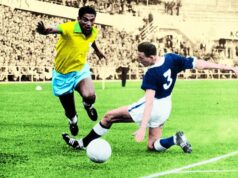When many talked about not having fencing after the World Cup, many individuals scoffed at the thought that this measure would last. Nine rounds in and there still have not been incidents that have challenged the posture as of yet. Now there haven’t been matchup that have generated a any type of challenge to this stance- until now.
We all know that Colombian culture is still very regionalized, therefore, you will not find a Superclásico as you would in countries like Argentina as well as in other countries in South America. Colombia’s clásicos are still based on that fan bases in various regions.
This is what makes Derby week so unique in Colombian football. Part of this round of rivalries is the fact that the history behind these matchups have so much history behind them. One of the biggest rivalries to be played midweek is at the Estadio Atanasio Girardot when reigning champs Atlético Nacional face their eternal rivals Deportivo Independiente Medellín in the 267th edition of the Paisa derby. We will aslo see a repeat performance at the same venue in the 268th edition this coming Saturday as well.
Between them there are 17 league titles, but also a great deal of friction and embattlement. This match will be no exception to the rule as both teams are currently fighting amongst the top spot in the league. The latter part is the more worrisome one as there is one big test that is going to challenge what is being pushed to be the new norm in this country’s football.
The Cultura de Estadio “The Stadium Culture” is a new movement in place that is trying to impose a counter to the violence that has plagued Colombian football for generations. The decision to not put fences back in the stadiums that hosted World Cup matches was one that was being looked at as borderline asinine.

We can remember when a fan at the Polideportivo Sur in the Medellín suburb of Envigado threw a bottle on the pitch and hit Atlético Huila’s Rafael Pérez after equalizing against Atlético Nacional. Pérez suffered a severe laceration as well as a cranial fracture after the bottle hit him in the head. The match was suspended at that point and the points were awarded to the visitors. Nacional would end up playing having a multiple match-ban which would be served prior to the playoffs.
What would make anyone think that behavior like that will not be the norm, especially with two fanbases that truly dislike each other.

The government of the City of Medellín is making a concerted effort to have the proper logistics by bringing in the appropriate number of police units. In addition to that, they will also bring in the appropriate alcohol breathlizer tests as well as checkpoints for weapons and things of that nature. Not only that, they have been using the different newspaper, television, and radio as well as different social media outlets to promote a peaceful clásico on both dates.
Although the appropriate measures (the ones that we are accustomed to) are in place, people there is a consensus that they do not want these to become protagonists en route to the stadium.
Many people in the media and the public service were talking about how the fences should have been raised as soon as the FIFA U-20 World Cup concluded back in August. If you were to think about that, it was the logical choice; the only choice. Whether it was a lack of money or a true commitment to change, we’ll have to see how they play out in the long term. Many call this the after effect of that tournament and the true belief that there was a chance to make things different. For many the time was perfect to implement this in Colombian football. It was now or never.
The positive is that both fan bases want this to continue and they are also making an effort to keep things they way they are now, despite their differences. In Medellín the implementation of the Cultura have been promoted heavily, ironically, by both clubs’ two biggest fan bases. The Rexixtenxia Norte as well as Los Del Sur have been at the vanguard of this movement according to their leaders.
Los Del Sur, Nacional’s historically largest and most notorious barra have been implementing this movement towards civility since the incident at the Polideportivo Sur. They were also adamant about changing their ways and it was on display during Nacional’s playoff run to their 11th league title.
Medellín’s Rexixtenxia also spread into the community to divulge the importance of having a healthy and peaceful environment.
Both fan groups have decided to meet up prior to the matches to have all of their members understand the importance of having this work for all.
Now the promotion that the Federation as well as the Colombian government have made to make this work are still in the initial stages.
This matchup, much like others that will take place in Bogota and Cartagena will be a testament to where Colombian fans are adapting to their new surroundings. Not only is it a sense of adaptation, it is also a way to turn the corner and show what Colombia is really about and where their passion lies. This is not talk about being in a Utopic environment, it is just baby steps in the proper direction.
The week that is could be a week that shows the world that a World Cup can make a difference in a country at a social level. Now the stage is set. The score will be vital in the standings, but the behavior of fans will probably say a great deal more than any result on the pitch.







